 One of the preoccupations of British comics fans is the future of the industry. The problems resulting from the economic crisis caused by the Coronavirus Pandemic and Lockdown aside, With the notable exceptions of Beano and The Phoenix, the traditional British comic has all but disappeared from newsagents. 2000AD and Judge Dredd Megazine are still being published, but, it would appear, to an ageing and slowly dwindling audience.
One of the preoccupations of British comics fans is the future of the industry. The problems resulting from the economic crisis caused by the Coronavirus Pandemic and Lockdown aside, With the notable exceptions of Beano and The Phoenix, the traditional British comic has all but disappeared from newsagents. 2000AD and Judge Dredd Megazine are still being published, but, it would appear, to an ageing and slowly dwindling audience.
Publishers are aware of the issues and are working hard to redress them – 2000AD, for example, with its Regened project. Fans, meanwhile, tend to look towards the United States for a model to follow to save the medium they love – but perhaps we might be better turning the other way, and looking towards Europe for a template for how the comics industry might survive and thrive?
Where better to start than, Europe Comics, the creation of Mediatoon Licensing, a Franco-Belgian comics agent, which publishes digital versions of European ‘albums’ and graphic novels.
Covering multiple genres and with a huge range of titles for kids, teenagers and adults, a look at their web site reveals just how rich and diverse the European comic market is.
Looking at a few recent releases under the Europe Comics banner at random reveals just how much variety there is in this company’s output, only seen on a regular basis in the UK, perhaps from publishers such as Myriad Editions, NoBrow and SelfMadeHero.
To examine just a little of what is available, we looked at the first volume of a long-established series, an almost brand-new graphic novel and something very exciting in the ‘coming soon’ category.

The Black Moon Chronicles is an epic fantasy series that began in the late 1980s. It was unique at the time, using modern, colloquial, French rather than the faux medieval-speak common in fantasy stories. While telling an epic story of swordsmen and magic, it had a heavy dose of irreverent humour that reflects writer François Marcela-Froideva‘s background in role-playing games.
The series has been a huge success, running to 20 volumes and giving rise to two spin-off series, an RTS (Real Time Strategy) videogame and a miniatures game. An online RPG was started but abandoned and fans have modded various other games to try to recreate the background of the graphic novels.
The first book, The Sign of Darkness, tells the story of Wismerhill, a half-dark elf, and his meeting with, Pile-ou-Face an elf with twin magical swords. The pair, after a shaky start, become friends and embark on a series of adventures culminating in their recruitment into a conquering horde led by half-ogre, Gorghor Bey. We’re also introduced to the land of Lyhnn, its Emperor and the various factions vying for power.
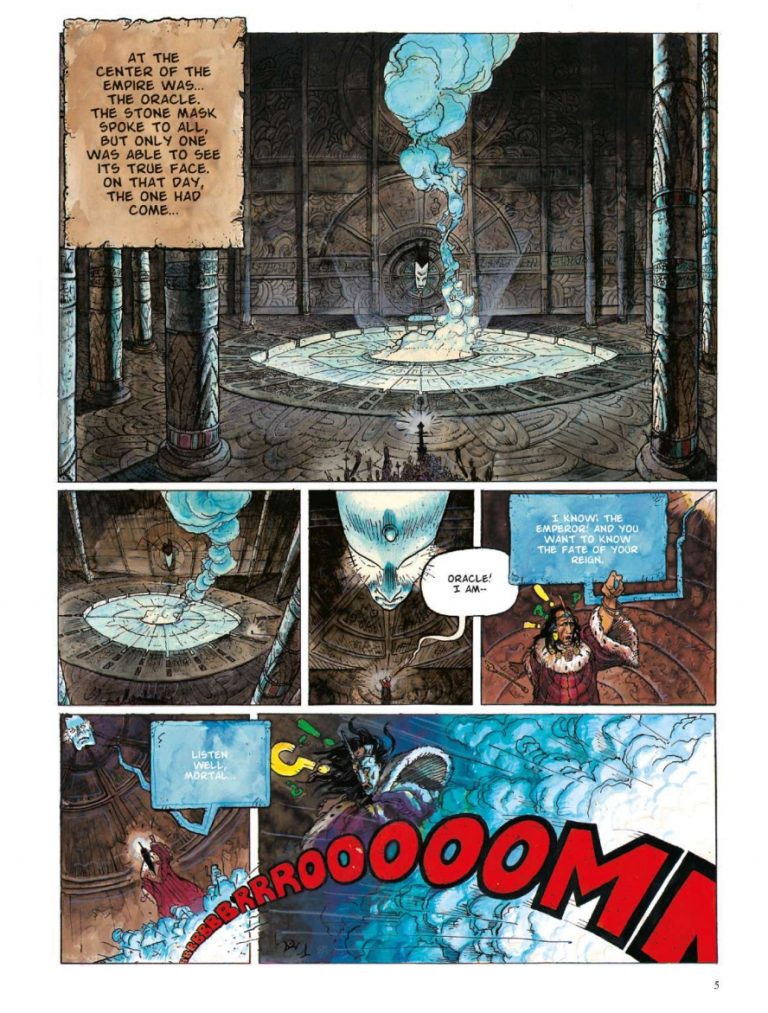
Hints are made of a great destiny awaiting Wismerhill, but here, as with any role-playing game, the lead character is very much on a learning curve. Influences are obvious: exaggerated versions of characters from the D&D game and, in the case of Pile-ou-Face, of Moorcock’s classic Elric character. (What better way to outdo a character who is ruled by his overbearing magic sword than to create one with two, battling, magic swords).
For readers used to the pacing of American and UK comics, the staccato rhythm of the storytelling might be difficult to get used to. Writer Marcela-Froideva can take pages over what appear to be minor incidents, while major events can be dealt with quite quickly.
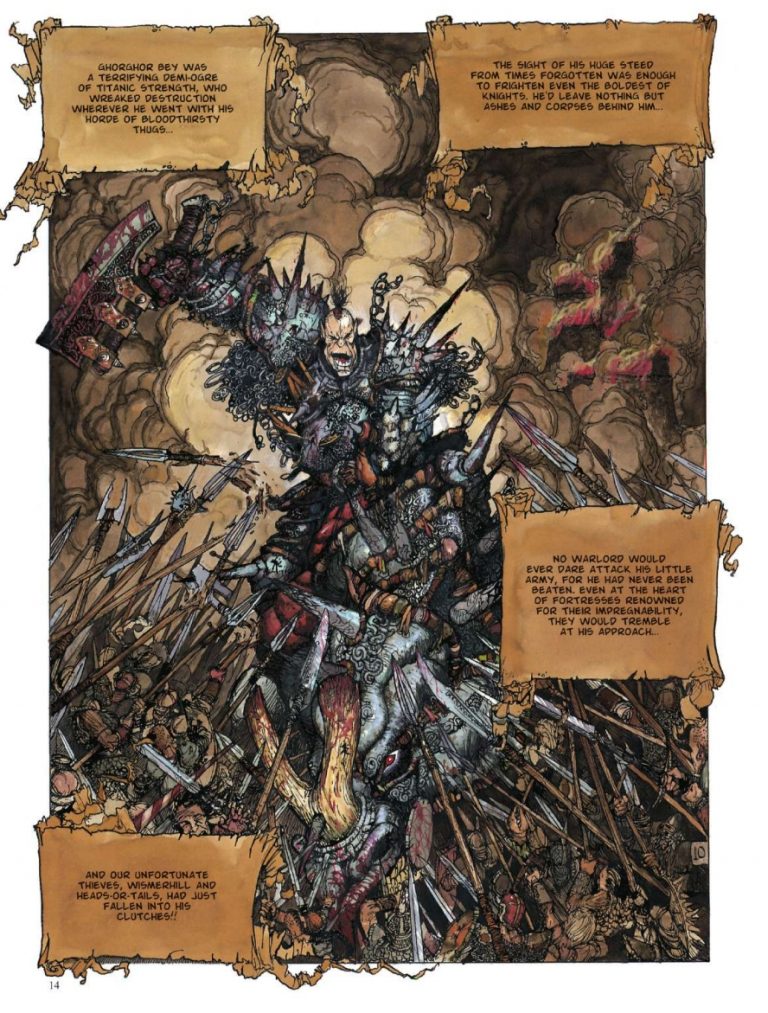
At its best, the art in this volume, by Olivier Ledroit, an artist best known here perhaps for his work on the Requiem saga by Pat Mills, recalls the loose and wild style of Philippe Druillet, especially his own Elric-inspired strip, Yragaël, but it’s more contained and controlled and, dare I say, easier to follow. There is a cartoony aspect to the drawing, but the action scenes are dynamic, enthralling and violent.

Art from Yragaël and Urm the Mad by Philippe Druillet
Overall, this is an interesting book for fantasy fans, especially gamers, a mixture of epic adventure and road-movie that promises a lot for future volumes.
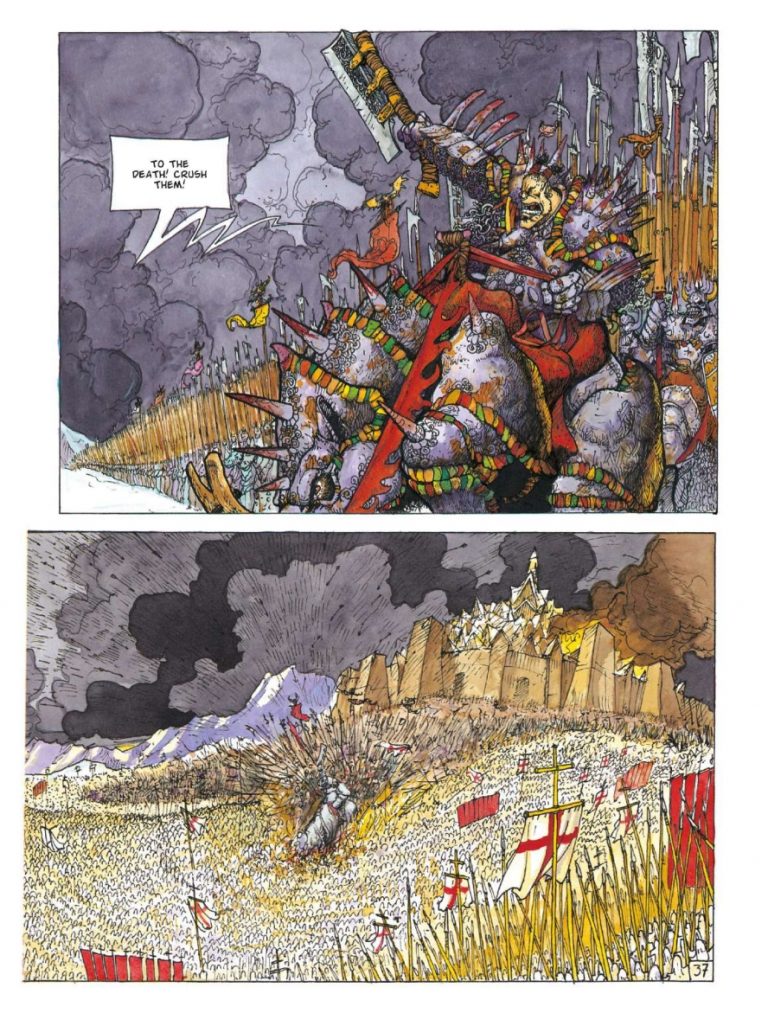 It’s also a demonstration of one of the key differences between the European and Anglo-American audience for comics. In the English-speaking market, the style of art is tied closely to the genre of comic. Bearing that attitude in mind, some of Ledroit’s linework might be regarded as too simplistic and amateurish, for either Slaine, or Conan. In contrast, Europeans seem much more accepting of mixing and matching genres and art styles – and that can mean that we can miss out on real gems that do not fit in with our prejudices.
It’s also a demonstration of one of the key differences between the European and Anglo-American audience for comics. In the English-speaking market, the style of art is tied closely to the genre of comic. Bearing that attitude in mind, some of Ledroit’s linework might be regarded as too simplistic and amateurish, for either Slaine, or Conan. In contrast, Europeans seem much more accepting of mixing and matching genres and art styles – and that can mean that we can miss out on real gems that do not fit in with our prejudices.

That’s also true of the “just released” book in this selection. Miss Endicott Part 1 is written by animation scriptwriter, Derrien and with art by Xavier Fourquemin, and is an action-adventure strip set in Victorian London. It tells the story of a redoubtable young woman as she returns from years abroad and takes over from her much-beloved mother as a Conciliator, helping the poor of the city with problems no one else is interested in.
The tone is light, the artwork of a particular type popular in France, at once “cartoony” yet highly expressive. Set mainly in the backstreets of a Dickensian London, with most of the action taking place late at night, there are few bright primary colours, with pale greens and browns predominate. The panels are rich with background detail but never muddy and the expressive faces, particularly that of Prudence Endicott herself, tell half the story.
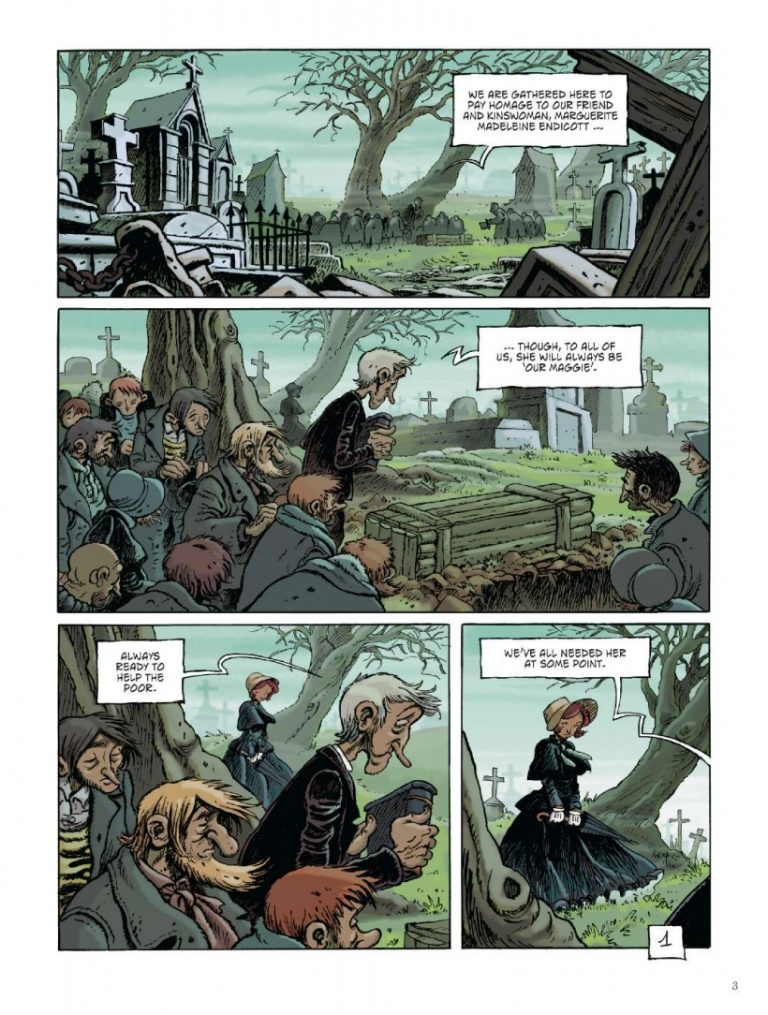
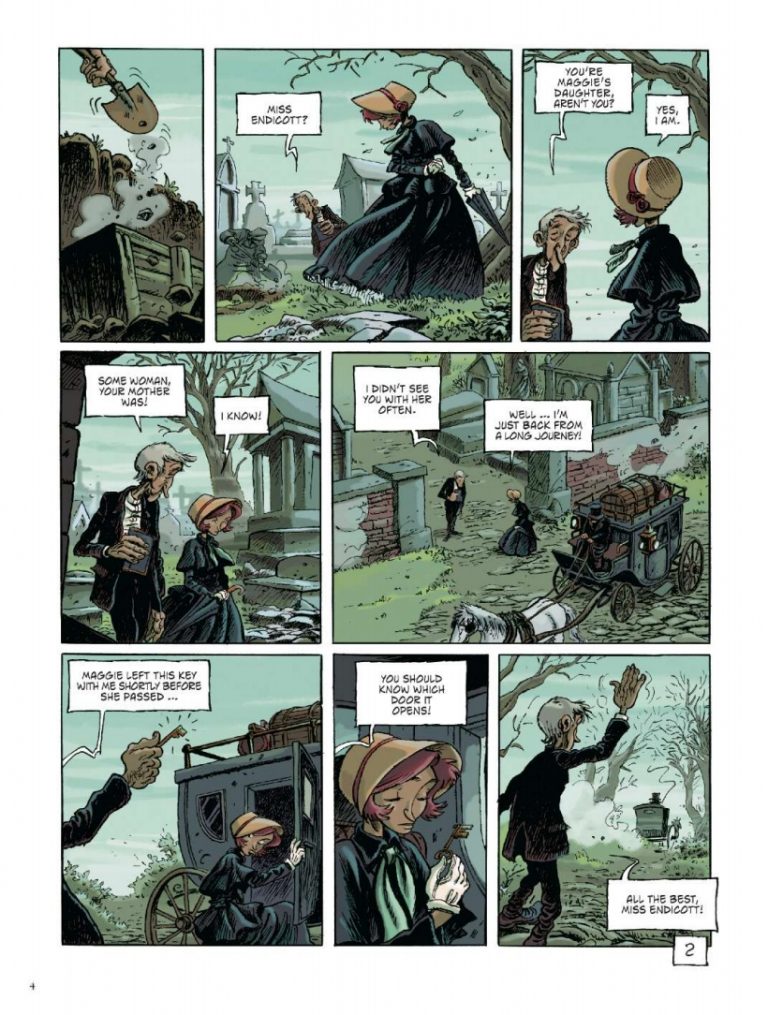
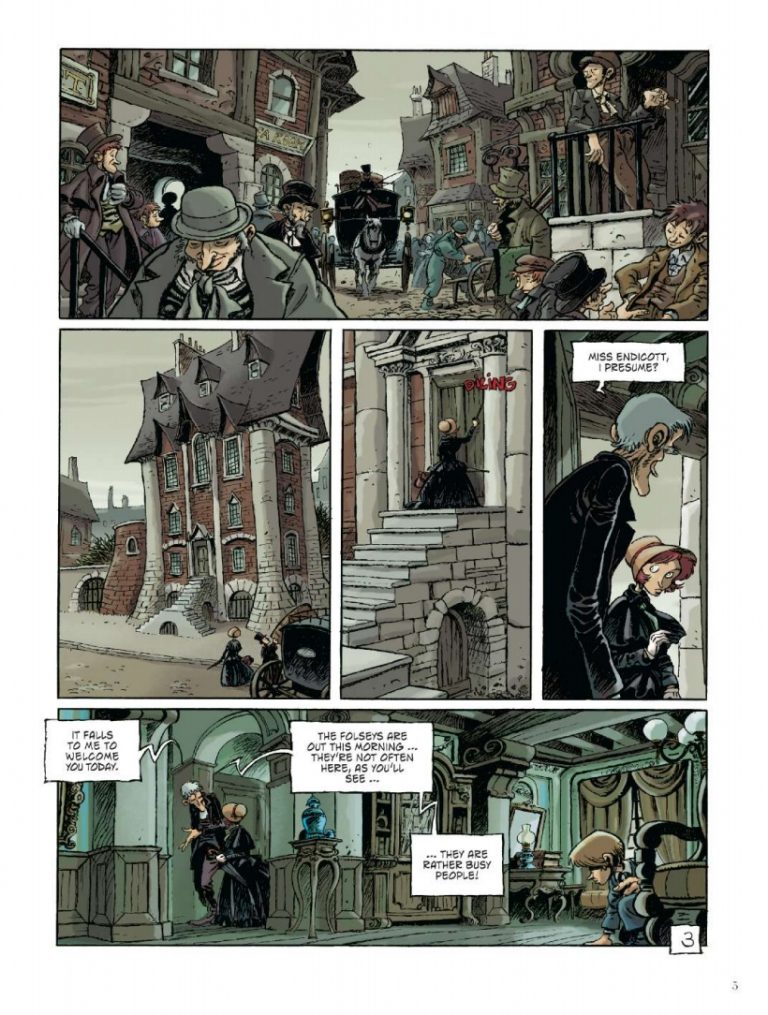
There is real subtly here, and while the translation is a little sparse and functional in places, the story is made warm and endearing by the artwork of Xavier Fourquemin. With almost 80 pages in the first volume, he and writer Derrien take their time establishing the background, the characters and all the elements of the main plot. It results in a gentle pacing not often seen in UK or American comics, and while it takes a little getting used to it does allow the story to build in a very intriguing way.
The second half of the book reveals that this is not quite the London we know. There are elements of steampunk and perhaps fantasy to the story, but nothing is allowed to overwhelm the good- humoured adventure and the background, characters and concepts serve the story, rather than the other way round.
Immensely, and surprisingly, entertaining, this book is another example of how different the Franco-Belgian comics tradition is. Volume One ends on a cliffhanger and while this was a title selected at random for a review, I will be back for the second volume.
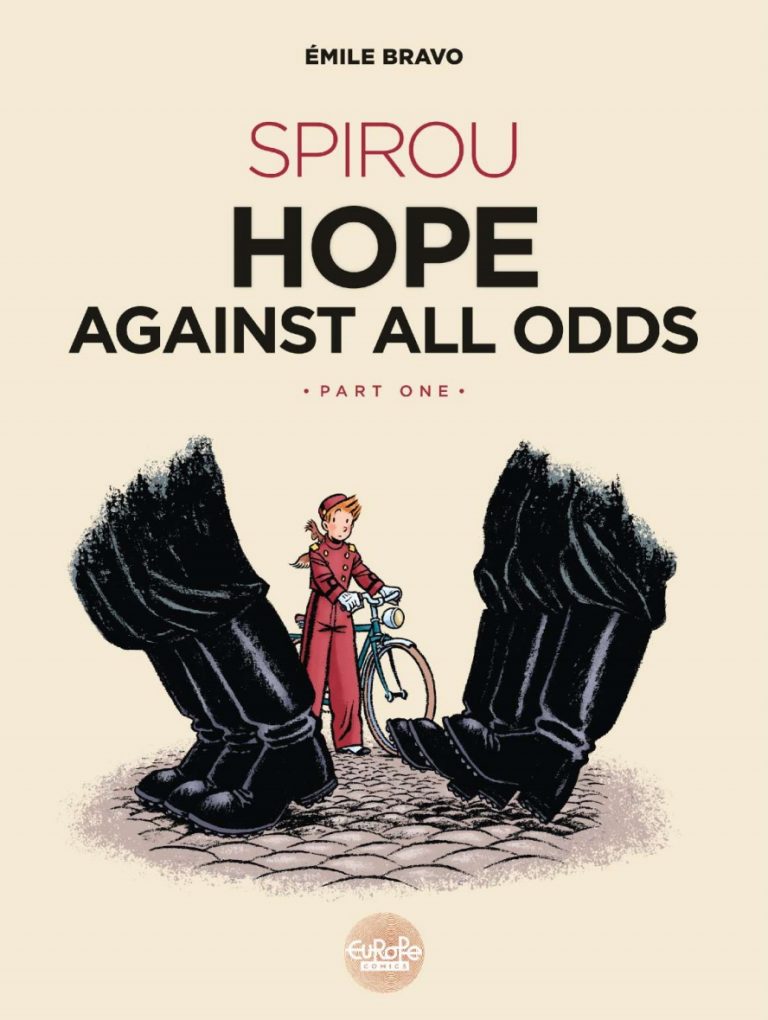
The next selection is, Spirou – Hope Against All Odds, the first book in a four volume set, which features one of the top characters in European comics.
Spirou was created for the launch of Le Journal de Spirou in 1938 and appears to this day in the weekly magazine. Founded on the success of Tintin, Spirou Magazine has been the main competition to Pilote, home of Asterix the Gaul and Lucky Luke, and Tintin’s own magazine, both of which it has outlived.
While the character of Spirou started life as a Lift Operator appearing in single-page gag strips, his adventures soon grew to match, and perhaps copy, those of Herge’s more famous creation with long serials and a cast of recurring characters. Spirou even followed Tintin into the world of journalism, making the comparison even closer and a little too obvious.
There was clearly room for both in the comics market. Spirou’s adventures were more humorous than Tintin’s, and survived a number of different creative teams to thrive, in one form or another until the present day.
Cinebooks are reprinting a selection of albums in English, but the volume we are looking at is something different. In 2006, publishers Dupuis launched a new series of one-off albums by various guest creators. The most acclaimed of these was An Ingenuous Boy’s Diary by Emile Bravo.
Bravo, however, had not finished with Spirou and he has returned with a new series of books looking at the early days of the character. Opening in Brussels in 1940, we start with a familiar, but charming, scenario where the young Spirou helps a crying child who is being excluded from the game of her older brother and his friends.
The boys are having a snowball fight, playing war, but then little details start to emerge that set the tone for the comic. They are taking sides, French and Germans; one of them even does the Hitler salute. It is all so innocent, and yet so chilling and sets the tone for the rest of the book.


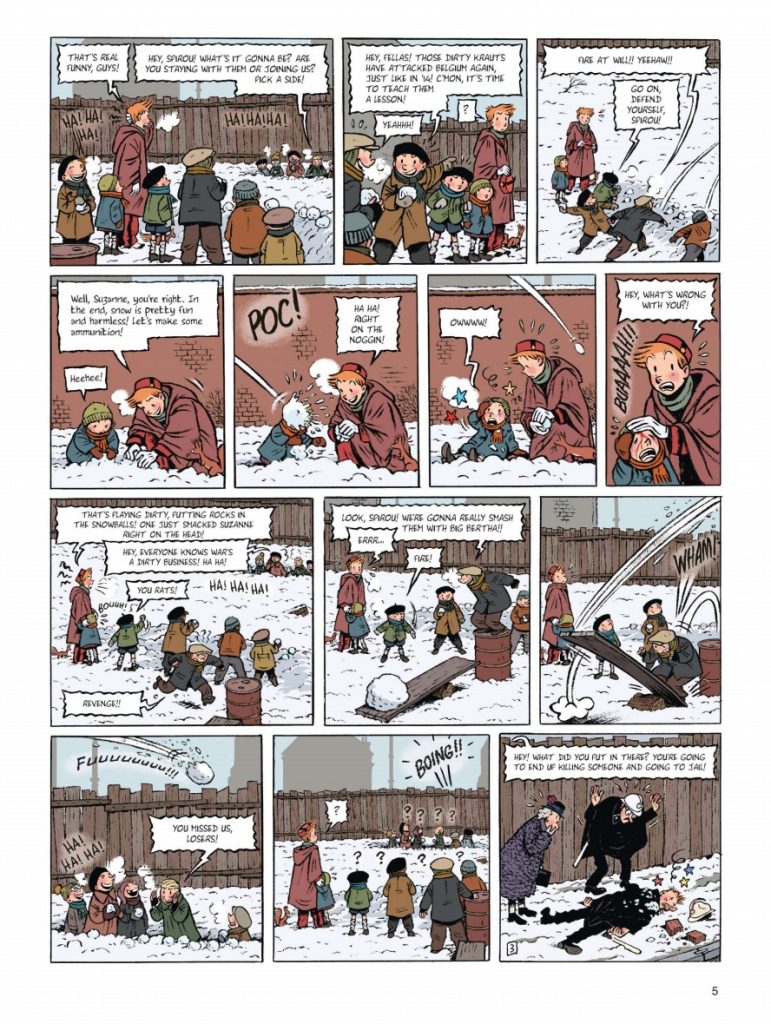 This is the war from a very different perspective, from the point of view of the ordinary citizen of Belgium watching helplessly as events unfold. There are no battles, no firefights or explosions – just a building dread and a feeling of confusion and helplessness as their world changes slowly around them.
This is the war from a very different perspective, from the point of view of the ordinary citizen of Belgium watching helplessly as events unfold. There are no battles, no firefights or explosions – just a building dread and a feeling of confusion and helplessness as their world changes slowly around them.
The artwork somehow adds to the feeling of unease. The style is like that pioneered by Herge, with clean lines, simple faces and pages densely packed with panels and dialogue.
When the invaders do appear, they are represented by planes flying overhead or troops marching wordlessly through the streets or passing in convoys of vehicles. When we do see an interaction, it is with some kids, at a distance and is an act of kindness by an individual soldier.
Bravo is telling the story of Belgium, not Germany or the allies, just this one neutral country that fell under the control of a ruthless and cruel regime. There are difficult issues involved in what happened in the country during its occupation. Even the beloved Hergé had his critics, being blacklisted after the war and openly accused of being a collaborator by the La Patrie newspaper, who lampooned him in “The Adventures of Tintin in the Land of the Nazis”, a vicious satirical strip.
Bravo takes those issues head on. Hope Against All Odds is about the dilemma that everyone faces when their values conflict with the rules. It’s about that decision to remain silent, when you see wrong being done or the feeling of uselessness when you realise no action you can take will help.
The promotional copy on the back of the book describes Hope Against All Odds as “a humanist tragicomedy in four volumes”. This first volume lives up to that tagline. It is a beautifully constructed, sometimes charming, sometimes chilling, comic that looks at a difficult time in a nation’s past, square in the eye in a compassionate, honest and accessible way.
Of all the reviews I’ve written, both here and on my old blog, Splank!, this is the one I’m most pleased to have put together. Here we had three comics that, but for this “assignment”, I’d likely never had read. All are first volumes in a series of books and in at least two cases I’ll be waiting impatiently for the next instalment.
I got to see one genre, fantasy, tackled in a very different way to the comics I am used to, I saw another, the Dickensian tale, that would be unlikely to tackled at all. Then I got to read the Spirou book. A comic that manages to be funny, warm and horrifying at the same time. That has something important to say and yet lacks cynicism or anger and is not knowingly clever.
There is lot we can learn from the European comics market, and a lot of fantastic material for us to discover.
Peter Duncan
• Europe Comics are online at www.europecomics.com
• Buy the Europe Comics digital edition of The Black Chronicles – The Sign of Darkness here
• Buy the Europe Comics digital edition of Miss Endicott – Part One here
• Buy the Europe Comics digital edition of Spirou – Hope Against All Odds here
Peter Duncan is editor of Sector 13, Belfast’s 2000AD fanzine and Splank! – an anthology of strips inspired by the Odhams titles, Wham!, Smash! and Pow! He’s also writer of Cthulhu Kids. Full details of his comics activities can be found at www.boxofrainmag.co.uk
Categories: Creating Comics, downthetubes Comics News, downthetubes News, Features, Reviews
 Shaman Kane storms back into action for an action-packed finale to latest adventure
Shaman Kane storms back into action for an action-packed finale to latest adventure  Latest EAGLE Times spotlights Classics Illustrated, an American Dan Dare, and more
Latest EAGLE Times spotlights Classics Illustrated, an American Dan Dare, and more  In Review: Into Battle: The Art of British War Comics
In Review: Into Battle: The Art of British War Comics  In Review: illustrators Issue 42 headlines with Richard Corben retrospective
In Review: illustrators Issue 42 headlines with Richard Corben retrospective
Not really sure what the author is trying to convey here. That there are some great Franco-Belgian comics? Sure, I think just about everyone knew that, even if they have not read any past Tintin or Asterix. That UK creators should take note and learn from their European counterparts, at least creatively? That does not help much, as the problem with UK comics is beyond stale creative styles and very much a distribution problem. So what is left? Publishers should try the “European” approach (I think many Europeans would feel offended that they are lumped together with the Franco-Belgians, but okay)? Aren’t they all in a steady decline as well, at least sales-wise?
So all in all, a nice review of some worthy books, but a misleading title and introduction!
At Editions Caurette (France) we’ve just signed a distribution deal with Turnaround to distribute our graphic novels and illustrated books in the UK. Our initial experience, 2 months in, is that the discounting environment in the UK makes the whole enterprise very challenging. In France it is illegal to sell books at a discount except to the trade, thereby protecting publishers and authors from heavy discounting. We have some great books available – but how long we can offer them to UK customers remains to be seen.
That is a terrible shame to hear the problems you’re facing. Discounting of books here has damaged the industry but has been in place for a long time.